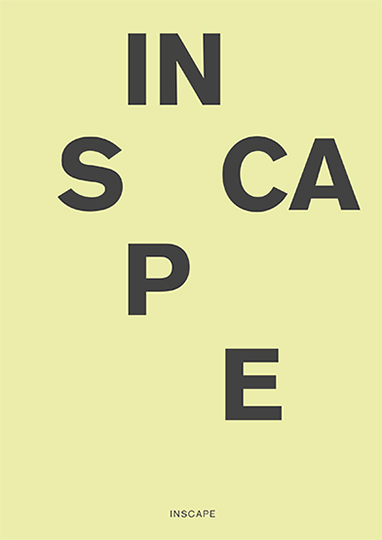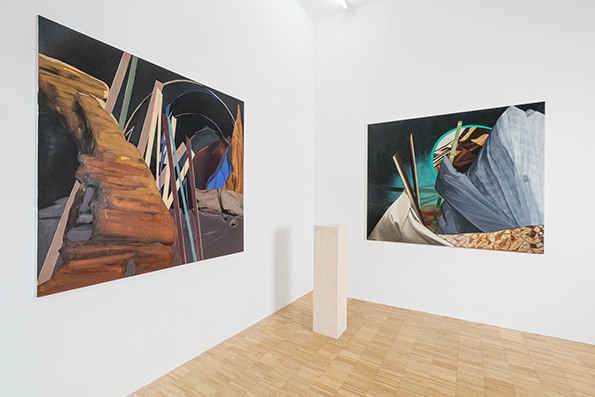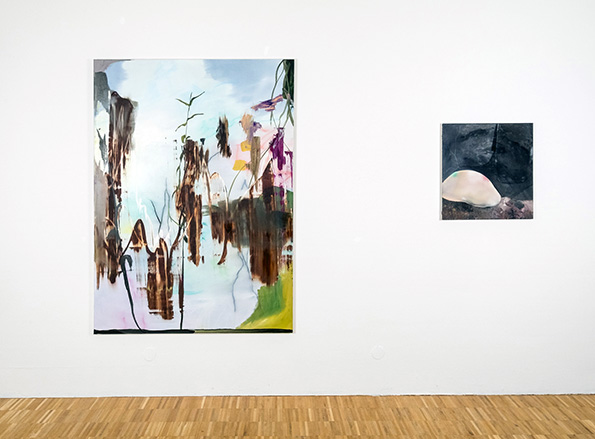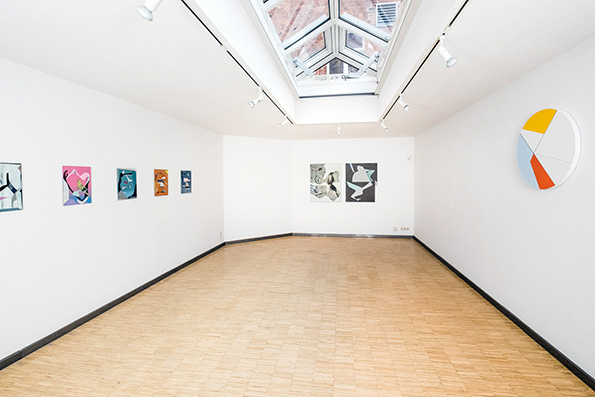INSCAPE

Isabelle Borges, Joanna Buchowska, Jessica Buhlmann,
Sophia Schama, Marcia Thompson
16.12.2016 – 27.01.2017
Eröffnung: Freitag, 16. Dezember 2016, 20 Uhr
Einführung: Christoph Tannert, künstlerischer Leiter Künstlerhaus Bethanien, Berlin

INSCAPE, Ausstellungsansicht
Jessica Buhlmann, Joanna Buchowska
Foto: Marcel Krummrich

INSCAPE, Ausstellungsansicht
Joanna Buchowska
Foto: Marcel Krummrich

INSCAPE, Ausstellungsansicht
Sophia Schama
Foto: Marcel Krummrich

INSCAPE, Ausstellungsansicht
Jessica Buhlmann, Isabelle Borges
Foto: Marcel Krummrich

INSCAPE, Ausstellungsansicht
Isabelle Borges, Marcia Thompson
Foto: Marcel Krummrich
The exhibition title, INSCAPE, may sound a bit cryptic. It is best to interpret it in the sense of ‘painting and its immanence, its essence’. First I would like to mention the commonalities I see in the exhibition: movement, for example, seems to be of secondary interest; there are hardly any active emotions to be seen; the brushstroke plays a subordinate role, if any. But all of it is presented in a very diverse, bold, technically skillful and always pleasantly defiant and unpredictable way. We experience a clear sense of time and development. Today, most abstract paintings try to be timeless and pure, which is exactly not the case in this exhibition.
Another aspect: even if the artists exhibiting here are not concerned with the question of the expressive gesture, the expressive in painting can be felt in the space as practically the opposite pole. All of the works shown here have nothing to do with expression. Therefore, these painterly approaches are not about finding one’s self, one’s identity as in the case of Expressionism, but about the identity of painting, something notoriously transient and difficult to define. For it is becoming increasingly difficult in the digital age for artists (as well as for the audience) to determine what part of one’s self the image represents.
The signs are emblematic, which means they are both signs and signs of reproduction. This provokes a state of non-presence: the feeling that something is missing, but one doesn’t know what. We are now in a different world, in the realm of feelings, of the Hollywoodian, the post-truth and not, like the Expressionists, in the realm of the sublime.
When it comes to the question of cultural identity, it is striking that all exhibiting artists and their works seem decidedly international. They know about all the world developments and also take into account the development of all artistic media, not just painting. And besides, these images display an admirable sense of relative size and proportion (from relatively small to wall-sized) and should therefore be understood not only with the head, but with the whole body.
It must also be mentioned that Monique Förster invited five women artists. 100% women’s power in an exhibition that does not point to the women’s quota is something noteworthy. Moreover it is interesting that one cannot tell, by looking at the pictures, that they were painted by women. I personally like it when I cannot tell whether a picture was painted by a woman or a man. For decades painting, especially abstract painting, was avoided by women because they thought it was an expression of male aesthetics. The situation has changed completely; today there are male painters who will only take part in a group show that has a certain number of women represented.
Let’s look at the artists individually.
Isabelle Borges was born in Brazil and lives in Berlin. Her main piece for INSCAPE is ‘Space in between’, a wall work specially designed for the Kunsthaus, in which lines and geometrical shapes organize the space. Another six ‘Bildboxen’ (2016) with color or mirror fields, which can reflect color depending on the lighting, are exhibited by her on the adjoining wall. These are synthetic space models, if you will. At times a collage of text fragments appears, but these are to be perceived less as content than an attempt to represent the medium’s background noise. Basically, Isabelle Borges is concerned with the question of how space can be described as a model in her aesthetic spatial research.
Sometimes the resulting imagery takes the form of an origami that opens itself up and at the same time remains as its outward appearance. The boundaries between drawing, object and painting are blurred. The line functions as an essential design element, it is the basis of an organic geometry that allows natural systems to emerge. For Isabelle Borges, nature is the model according to which the relationships between bodies and things are examined. Not surprisingly, many, many sketches are needed in the process.
All in all, this artistic approach is the attempt to represent different relationships to what space is. Borges’s spatial models are visualized as geometric and linear analysis. The effect is a result of the artist’s ability to find the right balance between density and reduction, between tension and release. She creates this through her sense of the necessary crossing of boundaries while simultaneously maintaining orientation with a well-tempered overall spatial concept. The interaction with the yolk-yellow spherical color clusters or the lavish layer of blue color over a small canvas by Marcia Thompson is particularly dynamic. Anyways, it is clearly a plus that the works are in a continuous question and answer relationship on the other floors, too.
Joanna Buchowska grew up in Poland and lives in Berlin. Originally she would spell out the titles of her work, but the audience seemed to take the information literally, which led to the reception of the images in unintended ways. So the artist decided to use abbreviations, rigorously doing away with narrative bridges. ‘Verlorene Jugend’ (Lost youth) became ‘v.j.’, ‘Schuhe nie am Vormittag kaufen’ (Never buy shoes in the morning) became ‘s.n.a.v.k.’, ‘Fromme Lebensführung’ (Leading a pious life) ‘f.l.’. In the case of ‘t.d.a.’ the unabbreviated title is in parenthesis: (the day after).
Already from the title choices one can see that Buchowska has no problem playing with associations, sometimes with open text nearing absurdity. Also because the audience approaches the works with their own foreknowledge and their own experiences and always, with or without concrete or encrypted titles, takes a walk through unsecured paths and into their own abysses.
The participation of the observer in the image cannot be underestimated. Buchowska’s titles, whether spelled out or abbreviated, are like attributions, a push in a direction that is never really the wrong one, but that can at times be more narrative or more concise. Thus, realities and worlds are not to be described, but rather unpacked as painterly events. These images are best interpreted as mysteriously open to communication. Surrender to the labyrinths with rich structures and flexible surfaces instead of creating meaningful connections exclusively based on language. Color plays a decisive role here, in addition to a conceptual collage principle, according to which Joanna Buchowska creates her world visions. It remains open whether these are science-fiction constructs or the problematized “totality of a consciousness of the world”.
Jessica Buhlmann, who comes from Potsdam and lives in Berlin, shows her glass paintings and canvases. The shape fragments of more or less closed color surfaces are the innovating forces in her paintings. Before our eyes a complex coexistence of spreading surfaces and interjections presents itself, with transitions as fluid as “a trip within the trip”. In an epigrammatic way the artist defends autonomy and objectivity in line with her identity as a painter. She does it in a way that surprises through formal reflexiveness and a striking stability.
These images have an inner life that seems to have been found rather than created and seems protected on a stretcher frame, preserved in oil on glass, on wood, precious, unique, but in tune with its surroundings. A warm abandon seems to emanate from them, something harmonious but that doesn’t try to produce a melody as a result. It is a sound of bright, multicellular moments in a gently streaming atmosphere. Freedom, spontaneity and improvisation set the mood.
The six glass paintings by Jessica Buhlmann have poetic titles such as ‘Shift’, ‘Stream’, ‘Alloy’, ‘Rain” or ‘Ascension’. The titles she distilled from her canvases are equally powerful and trailblazing. See for yourself.
Sophia Schama was born in Sofia, grew up in Homs, Syria and lives in Berlin. Her paintings in the basement reflect the concern with nature, with grass, with plant structures. We can read them as close to nature or close to the nature of painting, object-related or non-object-related, sharp or blurred. The artist is interested in the zones of aesthetic transition.
Nature, as well as the natural aspect of the painting process, becomes the site and anchoring place for seeing. Everything that is channeled through a seeing machine to our thinking machine is mutated, distorted, becomes an expression, a voice, a perspective, an aspect, possibly a spark of truth, that comes from us, but remains dependent on what was seen.
Sophia Schama manages to perplex us. Just look at a painting like ‘MO151016’. Seen from some distance, it resembles natural phenomena. We forget that this painting (and all of her other ones) has a creator. One sees them as materialized vegetable vascular tissue, as light-absorbing tissue, as representations of plant bodies, aerial roots, only because they are there. But less important than what is seen is the question of how it is seen. The challenging aspect of Shama’s choices in imagery is that she does it all with epic force, manifesting her refusal to merely depict reality.
Finally, a look at Marcia Thompson, who was born in Brazil – where she studied with Isabelle Borges – and lives in London. Thompson’s paintings are predicated on expansion: the gestural work of the brush is gone, the painting is literally transposed into another dimension. The color itself is staged as an event, as a mass, as an object. We are confronted with bodies of color with a canvas core.
The color becomes thick, it stretches, it breaks out, intervenes and creates a space of its own, which disregards the pictorial space, the canvas and the stretcher frame as much as the human proportions or the eye level.
It is incredible: the painting becomes independent of the experience of volume and space. The block of accumulated color establishes its own realm. This realm of the pictorial is the visible trace of the imagination, a space for thought within the dimensions of concrete space.
As you can see, INSCAPE reveals the current strengths of painting. It is precisely here – in its quiet reserves, from which they emerge unexpectedly and help boost the flagging Zeitgeist – that one can find a reason why painting, despite all the challenges and despite some hostilities (to which the medium was exposed, in parallel to the transformations of an advancing Modernity), continues to impose itself cheekily.
Exhibition opening speech: Christoph Tannert, artistic director Künstlerhaus Bethanien, Berlin. INSCAPE: Isabelle Borges, Joanna Buchowska, Jessica Buhlmann, Sophia Schama, Marcia Thompson, Galerie Kunsthaus Erfurt, 16.12.2016